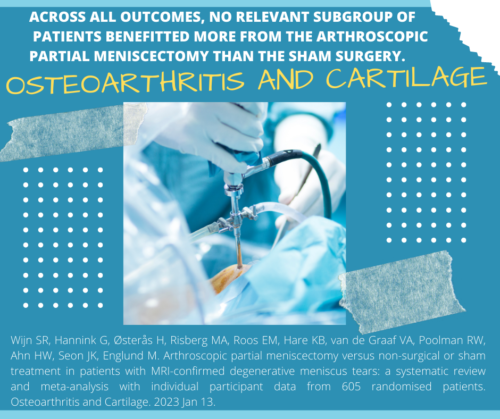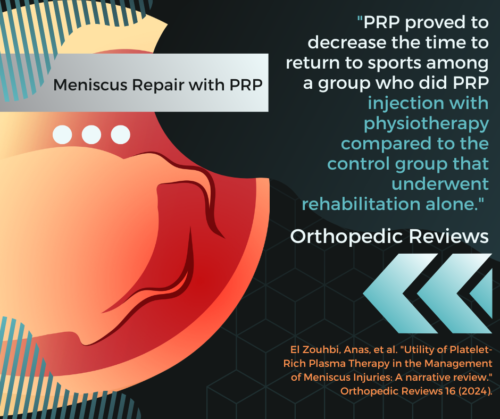
When an injury to the meniscus occurs, patients commonly try non-surgical meniscus tear treatments like rest, ice, compression, elevation, pain medications, physical therapy, and cortisone injections. When those do not work, their doctor may recommend arthroscopic surgery.
Surgery, though, has not been shown to be an effective means to treat meniscus injuries. Studies have found no significant difference between meniscectomy and sham surgery. And recent studies show that surgery does not reduce the mechanical symptoms of knee catching and locking, which patients often experience.
As you can see, the effectiveness of meniscectomies is questionable. So why do patients seek surgery to fix their meniscus?
When a patient is in pain, they want the pain to stop. And when an athlete has an injury, they want to get it fixed so they can return to the game. Therefore, they decide to receive surgery so they can return to the activities they love, believing that the surgery will restore knee function.
Sure, there are successful meniscus surgeries. But that’s not who we see in our office.
We see patients who want to avoid surgery and those who have continued pain after surgery. But what about people we don’t see? What are the outcomes of patients receiving surgical meniscectomy? And what does the research say about meniscus surgery?
The medical journal Cureus states, “Arthroscopic partial meniscectomy (APM) is currently the most performed orthopedic procedure around the globe. However, recent studies have conclusively shown that outcomes after an arthroscopic partial meniscectomy are no better than the outcomes after a sham/placebo surgery.” (1)
Do athletes who choose surgery to return to their sport more quickly achieve their goals? A team of doctors in the journal Knee Surgery, Sports Traumatology and Arthroscopy evaluated 421 elite athletes who received partial meniscectomy or a meniscus repair. They found that 84.7% returned to the sport after a partial meniscectomy (a piece of meniscus removed), and 78.3% returned to the sport after a meniscal repair (a small tear sewn with suture). (2)
The study also showed that although surgery allowed for a return to sports in these patients, it also increased the risk of developing knee arthritis. If you do the math, that means over 15-20% or about 1 in 5 elite athletes do not return to their sport. And those that do now have a higher arthritis risk.
Why does the risk of arthritis increase with surgery? The meniscus and the ligaments are stabilizing structures for the knee. When this soft tissue is cut and trimmed during the surgical process, the knee is destabilized. The knee instability sets the arthritic cycle in motion.
Surgeons have a more difficult time predicting who will benefit from meniscectomy in patients over 50. In the journal, Current Reviews in Musculoskeletal Medicine, reviewers wrote, “Despite an abundance of literature exploring outcomes of arthroscopic partial meniscus for degenerative meniscus tears, there is little consensus among surgeons about the drivers of good outcomes following arthroscopic partial meniscus.”(3)
In older patients or active patients with arthritis, more conservative therapies should be sought for meniscal tears.
That’s the exact title of an article in the British Journal of Sports Medicine. Researchers questioned whether orthopedic surgeons could predict the outcomes of treating meniscal tears with arthroscopic partial meniscectomy. The answer? The surgeons were only correct 50% of the time. How eye-opening! Only half the time, these experienced surgeons had it right when recommending that surgery be indicated. The results are no different than the flip of a coin!! (4)
Patients with meniscal tears and severe arthritis have a high risk of needing more surgery. The Indian Journal of Orthopaedics says, “Clinical practice is moving away from treating meniscal tears in patients with osteoarthritis unless there are mechanical symptoms (Knee function is significantly compromised). This study assessed the risk of needing further surgery for osteoarthritis in the five years following partial meniscectomy in different age groups and different grades of knee osteoarthritis”(5).
Unfortunately, patients are often too optimistic that surgery will fix everything. “In general, patients undergoing arthroscopic meniscus surgery were too optimistic regarding their recovery time and postoperative participation in leisure activities. This highlights the need for shared decision making which should include giving the patient information on realistic expectations. . .”(6)
In a January 2023 paper published in the journal Osteoarthritis Cartilage, researchers examined comparison studies between arthroscopic partial meniscectomy versus non-surgical or sham treatment in patients with MRI-confirmed degenerative meniscus tears. What did they find? Overall knee function and health-related quality of life did not differ between the two groups. And across all outcomes, no relevant subgroup of patients benefitted more from the arthroscopic partial meniscectomy than the sham surgery. (7)
Given these poor outcomes and up to 6 months of recovery time even in “successful” surgeries, what alternative does a patient with an injured meniscus have?
Regenerative Orthopedics, like Prolotherapy, PRP, and Stem Cell Therapy, stabilize the soft tissue structures and stop the arthritic cycle. As we said earlier, the meniscus is a primary stabilizing structure, as are the ligaments. When destabilized from meniscectomy, the abnormal motion will occur, and friction will increase, causing the acceleration of cartilage breakdown.
Regenerative Orthopedics will strengthen the ligaments, repair the meniscus, and stop the breakdown of cartilage.

PRP Helps Athletes Return to Sport Quickly
PRP has become popular in sports medicine and other knee injury situations due to its ability to improve the healing capacity of wounded tissues. At OrthoRegen®, our regenerative specialists may recommend PRP and Prolotherapy to repair the damaged knee.
• PRP is full of growth factors that boost the healing and repair of the damaged meniscus.
• Dextrose Prolotherapy is a successful treatment for the repair of ligaments and tendons. Whenever an injury is significant enough to damage a meniscus, it is also very likely that ligaments have also been damaged. Prolotherapy effectively repairs the damaged ligaments or involved tendons.
A 2024 article in the journal Orthopedic Reviews says, “PRP proved to decrease the time to return to sports among a group who did PRP injection with physiotherapy compared to the control group that underwent rehabilitation alone.” (10)
Additionally, the Journal of Education, Health and Sport reports how well PRP works in the healing of meniscus injuries. “Platelet-rich plasma has a positive impact on tissue healing in meniscus injuries. Platelet-rich plasma repair in the patients with meniscal tears leads to improved healing rates compared with patients without PRP injections.” (11)
A recent systematic review in the Arthroscopy, Sports Medicine, and Rehabilitation journal reviewed studies concerning outcomes for meniscus tears treated non-surgically with platelet-rich plasma (PRP). Four out of five studies reviewing pain outcomes showed that PRP significantly decreased pain levels. (12)
Regenerative Orthopedics are safe, conservative treatment alternatives for the injured meniscus. In the athlete and non-athlete alike, these treatments offer an effective non-surgical option for the repair of the injured meniscus.
Given the accumulation of evidence demonstrating the overwhelming lack of efficacy and benefit and the risk for serious adverse effects of this widely used procedure for meniscus tears, it is essential to consider potential safe and effective alternatives.
Regenerative Orthopedic treatments boost the healing process, raise growth factors, and initiate repair. The treatments stimulate new cell growth and rebuild depleted tissue, including cartilage regeneration.
Regenerative Orthopedic treatments can safely and effectively treat meniscus tears non-surgically, returning you quickly to the activities and sports you enjoy.